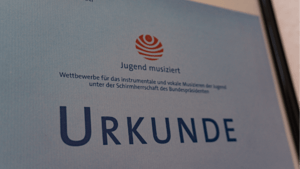Jugend musiziert facts for kids
Jugend musiziert is a very popular music competition for children and young people. It takes place in Germany and Austria. Almost a million young musicians have taken part in Jugend musiziert over 57 years. For many, this competition was the first step towards a successful music career.
Contents
Jugend musiziert in Germany
In Germany, this national competition is for children and teenagers up to age 21. For singing and organ players, it's open up to age 27. The competition helps young musicians grow, compare their skills with others, and get support. Participants cannot be studying music professionally or working as professional musicians yet.
How the Competition Works
Musicians play pieces from different time periods. The length of their performance depends on their age and the rules for each category. It can be from 10 to 20 minutes long.
The competition has three main stages:
- Regional Level: First, it starts at a local level. There are about 140 regions in Germany and around 30 German schools in other European countries that host these first rounds.
- State Level: If you win a "1st Prize" at the regional level, you move on to the state competition. Some German schools in Europe also have their own state competitions.
- Federal Level: Winners of a "1st Prize" at the state level, who are old enough, can then go to the national (federal) competition.
Musical Categories and Instruments
The types of solo and group categories change every three years. When "Jugend musiziert" first started, it focused on classical orchestral instruments. Over time, more instruments and categories were added:
- In 1970, the piano was included.
- Later, drums, plucked instruments (like guitar), and vocal categories were added.
- In 2009, the solo category for "Bass (Pop)" was introduced.
- After that came "Guitar (Pop)" and "Vocals (Pop)".
- In 2015, a new solo category called "Special Instrument" was added. This included instruments like a chopping board and baglamas! In 2016, this became an ensemble (group) category for the first time.
Participants and Support
In 2015, over 20,000 young people took part in "Jugend musiziert" across Germany. About 7,500 of them went on to the state competitions. Nearly 2,400 winners from the state level then competed at the federal competition.
The German Music Council has supported this national competition since it began in 1964. Many groups help run it, including music teaching associations and music schools. The competition also gets funding from the German government and local banks like the Sparkassen-Finanzgruppe.
2020 Cancellation
In 2020, for the first time in its 57-year history, all state and federal competitions were canceled. This happened because of the COVID-19 virus.
Jugend musiziert in Austria
The Austrian competition started in 1969 in Leoben. It was for young musicians from Austria and South Tyrol. It included instrumental and vocal performances. The age limits were 10–21, but a bit older for some instruments and singers.
Competition Structure and Changes
This competition happens every two years. Since 1975, it has included "state competitions" in the main cities. Winners then go to the "federal competition" in Leoben. Young musicians from all Austrian states take part. The group from Tyrol also includes participants from South Tyrol.
The number of participants in Austria grew a lot. It went from 235 in 1969 to over 2,000 by 1989. People involved in the competition suggested new ideas. They wanted it to happen every year and to have different levels. They also wanted to include more instruments and have a required piece from the 20th century.
In 1993, the competition was held nationwide under the old name for the last time. After that, the Austrian states and government ministries created a new organization called "Musik der Jugend." This group now organizes a similar competition called "Prima la musica."
In Leoben, the original "Jugend musiziert" group still holds smaller competitions. These are for specific categories and happen at different times.


